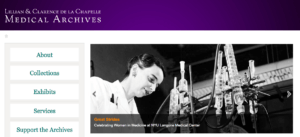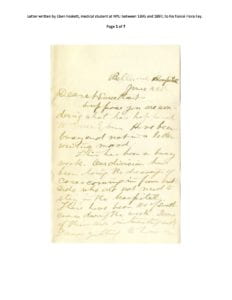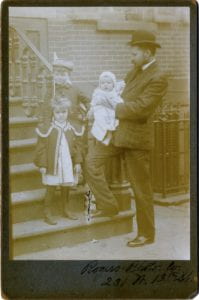On October 14, 2016, the Research Collaborative visited the NYU Medical Archives. Sushan Chin, Head Archivist and member of the collaborative, hosted the group. Our visit covered the collecting areas of the Medical Archives, a hands-on activity with items from the archives, a discussion of Superstorm Sandy’s impact on the medical center library and archives, and a broader look at preservation issues and access. Prior to the visit to the newly renovated library, the collaborative read Sushan’s article, “Surviving Sandy: Recovering Collections After a Natural Disaster.”
Science and engineering archivists Lindsay Anderberg (Poly Archives) and Leah Loscutoff (Stevens Institute of Technology Archives) were interested in the Medical Archives’ work in oral histories as a way to humanize researchers and doctors and to explain complicated scientific innovations documented in collections. NYU University Archivist, Janet Bunde, pointed out that collecting these oral histories now will be beneficial for future anniversary celebrations for the university. Other collections, such as a pharmaceutical bottles and microscopes captured the interest of professors, such as Chris Leslie, who thought about how these collections could be used with current STEM students.
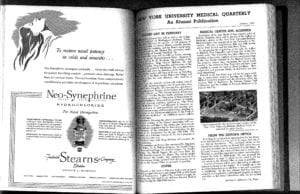
During the hands-on activity, we broke into three groups and explored five items from the archives. One group studied the Medical Quarterly, with the page above marked. This group not only learned about the history of the medical center, but also thought about how an article like this could help students to think about place and changes over time.
An unidentified letter and photograph were distributed to the second group. The group read the letter aloud together in an effort to decipher the handwriting. This strategy often required the group to read ahead and circle back to work out what words might be based on context. While more work than reading a transcribed letter, this type of reading prevented skimming and the group enjoyed discovering the contents of the letter together– from a description of riding in the ambulance to tend to a man hit in the head with a hammer to reassuring his sweetheart that he was safe and there are “tough skulls among the stable gang.” Descriptions of medical practice, personal anecdotes, and daily life in New York City co-mingle as the handwriting drifts from legible, to scrawling (perhaps a tired hand?).
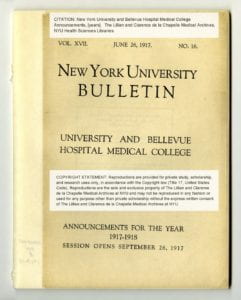

The third group explored the 1917-1918 course catalog for NYU and Bellevue Hospital Medical College and a photograph of a surgical theater. Historic university catalogs and bulletins provide valuable insights into trends in STEM education as well as a resource to learn more about professors associated with the school.
Research Collaborative members, please add your thoughts to the comments! What ideas did this visit spark about your own work in terms of access, outreach, preservation, medical collections, or research?

